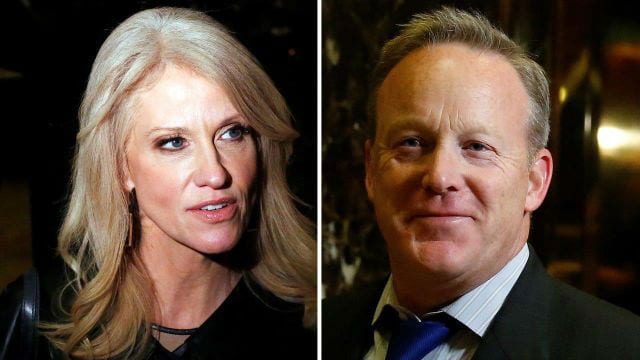BY COLLEEN COYLE – STAFF WRITER
Kellyanne Conway has a knack for performing interview gymnastics, twisting away from direct answers, spinning around tough questions, and sometimes improvising when she considers it necessary. Simply watch a video of Ms. Conway on any major cable news network and you can’t help but admire her verbal agility, as she redirects questions to a topic she is more comfortable discussing or towards an opportunity to attack the opposition. Ms. Conway’s rhetoric skills have gained her notoriety in the news media, as different news agencies have posted articles carefully deconstructing her tactics, strategies, and abilities.
She has even gone so far as to excuse the inaccuracies reported by Sean Spicer, White House Press Secretary, as “alternative facts”. It should come as no surprise then, that on a February 2 interview with MSNBC where she defended President Trump’s recent hold on immigration from majority Muslim countries, Ms. Conway invented an entirely new “alternative fact” by citing the Bowling Green Massacre.
Each incident, first with Mr. Spicer and Ms. Conway’s “alternative facts” and then with the “Bowling Green Massacre,” demonstrate an important trend developing in the new Trump administration of treating facts loosely and rhetoric as a priority. Is this a reflection on Trump’s advisors and their experience levels or is this more indicative of a broader conflict between conceptions of truth, media reputability, and public trust in government institutions? As with many things, I believe the truth lies at an intersection of all these ideas but that Ms. Conway with both her verbal dexterity and comfortability with unverified claims has contributed and heightened each of these conflicts.
First, who is Sean Spicer and what does he bring to the table? Serving as the White House Press Secretary, Mr. Spicer has already become notorious for his battles with mainstream press as he works to defend the tweets and actions of President Trump. Mr. Spicer does offer a notable amount of experience, serving as a trade minister for George W. Bush, working closely with the Republican National Committee on issues of communications, and working closely with Reince Priebus, President Trump’s Chief of Staff. Spicer’s history also includes a battle with the ice cream company Dippin’ Dots (which happen to be made here in Kentucky), though the origins of Spicer’s conflict with the ice cream company remain mysterious.
His issues with the mainstream American press became evident at an early statement where he disputed the size of President Trump’s inauguration crowd. Mr. Spicer, though capable of defending himself and the administration, lacks Ms. Conway’s skill and made himself an easy target for SNL comedian Melissa McCarthy, who did a blistering impersonation of his press briefings. Mr. Spicer’s early falsehoods, disputes with the press, and occasional factual inaccuracies, has set the stage for a new relationship between the mainstream media and the White House, as both legitimize their claims to the truth and create a divide between those citizens who are inclined to believe the media and those who are inclined to believe the White House. Mr. Spicer has become the figurehead of this division and will likely remain.
Ms. Conway, in contrast to Mr. Spicer, is more difficult to nail down. Even with a brazenly false comment, such as her reference to the “Bowling Green Massacre,” Ms. Conway suffered minimal actual backlash from her claims. She developed an impressive reputation as someone who could rein in Donald Trump on the campaign trail and as a counselor to the President; Ms. Conway continues her legacy of political back handsprings and aerials. Ms. Conway has had a great deal of experience, running her own polling firm, advising GOP clients in dicey situations, and even authoring a book What Women Want. To call Ms. Conway inexperienced would be a great disservice and an underestimation of what Ms. Conway can achieve.
On February 2, Ms. Conway cited the “Bowling Green Massacre” as evidence that refugees have carried out violent attacks on American soil, and tied it to President Obama’s hold on immigration in 2011. However, Ms. Conway’s statement was quickly proven false, and although Ms. Conway claimed she had made a mistake, institutions like the New York Times, the Washington Post, and others found that Ms. Conway had cited the “Bowling Green Massacre” in interview’s with TMZ and with Cosmopolitan before her claim on MSNBC. However, despite Ms. Conway’s obvious falsehood, there has been no significant backlash, besides some scathing articles being released.
Ms. Conway and Mr. Spicer’s frequent diversions from the truth would at first appear to be an issue of experience, however, both have extensive experience in the political arena. Thus these inaccuracies and falsehoods indicate a broader conflict, one where two groups are struggling to have the power to define what is true. If the White House can gain authority to claim only they tell the truth, they gain an insurmountable upper hand in achieving their goals. The Bowling Green Massacre, though it did not actually occur or claim any human lives, the casualties include political accountability and a national faith in the U.S. news media. The question remains whether or not the political news media will take steps to resurrect such things or if they will go down in history alongside a false reference to a false event.

